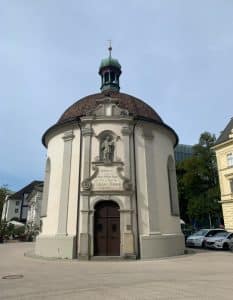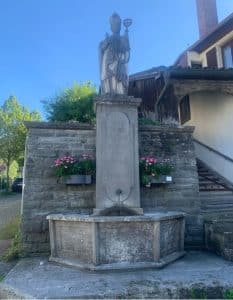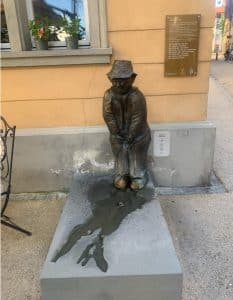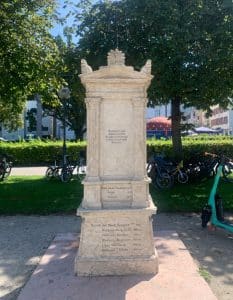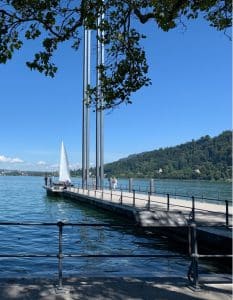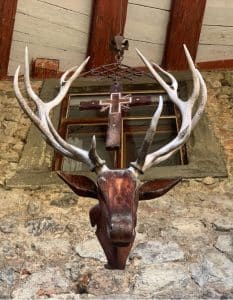Located in the heart of Bregenz, Austria, the Kapuzinerkloster (Capuchin Monastery) is a significant historical and spiritual site that has been standing since 1639. This monastery, home to the Capuchin Friars for centuries, offers an intimate look into monastic life and history while providing a serene retreat from the bustling city.
The History of Kapuzinerkloster
The construction of Kapuzinerkloster began in 1628 under Count Kaspar Ignaz von Kuenburg but was only completed eleven years later due to interruptions by the Thirty Years’ War. The main church attached to it was consecrated on September 3rd, 1641. Over time, this religious institution has seen many changes – it survived wars and revolutions and bore witness to countless historical events.
In its early days during the Counter-Reformation period, this monastery played an essential role in promoting Catholic faith across Vorarlberg region. The monks did not just limit themselves within their cloistered walls but ventured out into local communities teaching catechism classes and ministering sacraments.
Architecture & Artistry
Kapuzinerkloster’s architecture reflects its historical timeline with a blend of Baroque elements incorporated within its otherwise simplistic design reflective of Capuchin order’s vow towards poverty. Its facade is unpretentious yet dignified; however, as you step inside you are greeted by breathtakingly beautiful frescoes adorning its vaulted ceilings.
The high altar created by Johann Joseph Christian in late baroque style stands as one of most stunning pieces within monastery featuring statues depicting scenes from life of St.Francis – founder figure for Capuchins. Additionally there are several other altars dedicated to various saints like St.Anthony Padua and St.Fidelis of Sigmaringen.
Life in the Monastery
The Capuchin monks have always led a simple, contemplative lifestyle dedicated to prayer, work and community service. Despite their secluded lives within monastery walls, they’ve played an integral role in local communities providing spiritual guidance and support. Even today you can witness monks going about their daily chores or participating in religious services adding to authentic monastic experience for visitors.
Visiting Kapuzinerkloster
Kapuzinerkloster remains open for public visits throughout year allowing tourists to delve into historical richness that it holds. The church is accessible during daytime hours while guided tours are available upon request offering deeper insights into life at monastery and its history.
If you’re seeking tranquility amidst your travels then Kapuzinerkloster’s quiet courtyards offer perfect solace where one can sit back reflecting on profound silence that surrounds these ancient walls. You may also attend mass services held here regularly which provide unique opportunity to engage with local culture & spirituality.
Around the Monastery
Beyond its sacred confines, Bregenz offers much more for explorers. Nestled by Lake Constance (Bodensee), this Austrian city boasts stunning landscapes along with rich cultural heritage including Martinsturm (Martin’s Tower) – oldest building in town dating back to 13th century, Vorarlberg Museum showcasing regional art & history or Kunsthaus Bregenz – an architectural masterpiece housing contemporary art exhibitions.
In Conclusion
A visit to Bregenz wouldn’t be complete without exploring the historic Kapuzinerkloster – a site steeped in centuries of religious tradition and fascinating history waiting eagerly for your discovery!
Frequently asked questions
What are the opening hours and admission fees for Kapuzinerkloster in Bregenz?
The Capuchin Monastery (Kapuzinerkloster) in Bregenz is generally open to visitors throughout the day. However, it’s important to remember that this is an active monastery where monks live and work, so certain areas may be restricted at times. As for the admission fee, entry into the monastery itself is usually free of charge but donations are always welcomed as they contribute towards maintenance costs.
What historical significance does Kapuzinerkloster hold?
The Capuchin Monastery in Bregenz was founded back in 1635 during a time when Austria was heavily influenced by Catholicism. The site has been home to generations of Capuchin friars who have contributed significantly to religious education and social welfare within the region. It also served as a refuge during wartime periods. Today, its history can be appreciated through various architectural features including its traditional cloister layout and baroque chapel.
How do I get to Kapuzinerkloster from central Bregenz?
Kapuzinerkloster is conveniently located near central Bregenz making it easily accessible on foot or by public transportation. If you’re walking from downtown area, simply head east towards Maurachstraße then turn onto Kapuzinerstraße where you’ll find the monastery entrance after a short stroll uphill. Alternatively, local bus services often stop nearby at ‘Bregenz Klinik’ station which leaves just a few minutes’ walk up towards St Gebhard Straße.
Can I attend mass or other religious services at Kapuzinerkloster?
Absolutely! Visitors are more than welcome to participate in regular masses conducted at Kapuzinerkloster. It’s an active monastery with daily services, and on Sundays and religious holidays, there are usually additional masses. This can be a wonderful opportunity to experience the spiritual atmosphere of this historic site. However, please remember to respect the sanctity of these ceremonies by dressing modestly and behaving appropriately.
Are guided tours available at Kapuzinerkloster?
While Kapuzinerkloster is open for individual exploration, guided tours are not typically offered as it remains a functioning monastery. Visitors are encouraged to wander around independently while respecting the peace and privacy of its resident monks. Nevertheless, informative panels placed throughout provide insight into various aspects of monastic life as well as the historical significance of certain areas within the complex.




